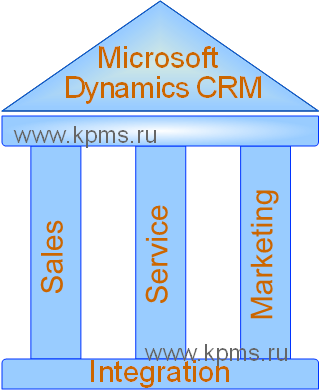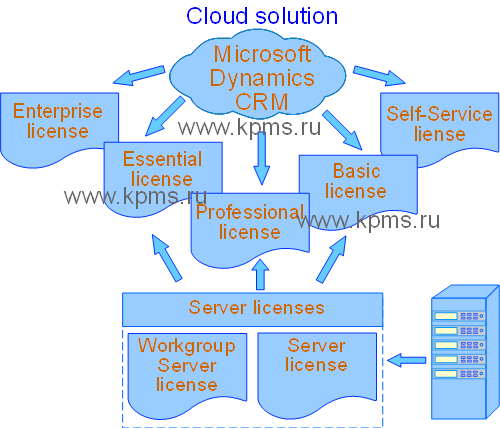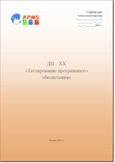The Microsoft Dynamics CRM system was first introduced to the market in 2003. Many updates and releases of the CRM system have been released during the period of its existence and development. The latest version is the release of Microsoft Dynamics CRM 2016, which was released in December 2015. In November 2016 Microsoft Dynamics CRM 2016 received an upgrade to the new rebranded – Dynamics 365.
Microsoft Dynamics CRM system
Microsoft has attracted more customers than any other suppliers of similar systems despite the rather late entry into the CRM solutions segment. It is a recognized industry leader in corporate CRM systems.
Microsoft Dynamics CRM offers specialized solutions for various industries and sectors of the economy: the public sector, financial services, manufacturing, healthcare, retail, services, education, etc.
Dynamics CRM automates the main functions of customer interaction: sales, marketing, involvement, service, analytical data processing. The system provides collaboration with many applications: Office 365, SharePoint, Yammer, Skype, Cortana Analytics, PowerBI, Windows Azure, etc.
Microsoft Dynamics CRM uses several technologies to support user activities. It can be delivered in the form of cloud solutions (SaaS), installed on a local server (on-premise), run on the platform.NET framework. This allows developers to integrate the CRM system with other applications via web services. Mobile work is possible via iPhone, Android and Windows Mobile devices.
The system is offered in 44 languages in 130 countries. If the company operates in several countries, then each country can have its own language version of the system installed, while all offices will use a single database. Microsoft data centers operate all over the world, which speeds up the data processing.
Dynamics CRM is compatible with all popular Internet browsers: Internet Explorer, Firefox, Safari and Chrome.
Microsoft Dynamics CRM Structure
Microsoft Dynamics CRM is based on the modular principle like most CRM solutions. The main modules of the system are: sales, marketing and service. In addition to them, solutions have been developed that provide certain types of customer interaction and support activities. All modules work on a single database, while users have access to functionality that corresponds to their specialization.

- The sales module gives users the tools to successfully manage each stage of the sales process: from lead processing to analyzing the effectiveness of the transaction.
- The marketing module simplifies aspects of managing marketing campaigns and mass communications, including direct mail, telemarketing, working with email and social media.
- The Customer Service module is a central repository for all customer information, allowing service representatives to provide better and faster customer support.
Additional solutions provide: mobile work with the CRM system, managing customer interactions through social channels, creating, maintaining and publishing information from the knowledge base.
Options for working with Microsoft Dynamics CRM
The CRM system from Microsoft can be used in several ways. They are determined by the technology of work with the system.
Work opportunities are provided for the 2016 release:
- based on cloud technologies, when a software product provides as a service (cloud solution);
- based on a local server (on-premise), when the software product is installed on the company's own server.
You need to purchase separate licenses to work in both cases. The functionality of Microsoft Dynamics CRM depends on the type of license.
If you need to use Microsoft Dynamics CRM only as a cloud service, then there are five types of licenses for this case. They are called Online User Subscription License (OSL), refer to the users of the system and are not tied to devices.
License options for working with cloud services include:
- Dynamics Employee Self-Service - the license required for organizing access of employees (system users) to general information (information portal, IT support service, corporate knowledge base, etc.). Employees will be able to independently find answers to questions that occur in their work.
- Dynamics CRM Online Essential - This license option is necessary for users who are not related to sales, customer service or marketing functions, but they need access to activity management, promotion channels, user applications, accounts, contacts and knowledge base articles.
- Dynamics CRM Online Basic - the license is intended for users with a minimum level of needs in the CRM system functionality. It gives access to the basic functionality of CRM: working with accounts, contacts, leads, reporting, toolbars, interactive services, incident management, etc. Business analysts will need a basic license to work with Microsoft Dynamics CRM reporting.
- Dynamics CRM Online Professional – it designed for sales professionals. It gives access to the system capabilities of sales, customer support and marketing. The license allows access to social activity management modules, collaboration tools, Service Desk services, knowledge management modules, etc.
- Dynamics CRM Online Enterprise - a license that provides maximum access rights to the system. Users can use all the features of Online Professional and advanced functions for sales management, marketing and customer support.
If the system is installed on a local server (on-premise), then server licenses will be required to install it.
The CRM system can be installed on the server in two ways:
- Microsoft Dynamics CRM 2016 Workgroup Server. This option allows a limited number of users (no more than five) to work with the system. The server can only be installed in one organization and run in one instance.
- Microsoft Dynamics CRM 2016 Server. There are no restrictions on the number of users of the system for this license. The server can support several enterprises belonging to the holding. It is possible to install multiple server instances and install role-based services.

You will need to purchase licenses similar to working with the cloud version of the system (USL) for users to work on the server version. When you set the system on a local server, three types of licenses are available to users: Essential, Basic and Professional.
Microsoft Dynamics CRM functionality
Sales automation module.
This module is the main and most functional in the Microsoft Dynamics CRM system. It combines ease of use and flexibility of sales management.
The main functions of the sales automation module:
- lead management. It allows you to create, view, edit, import and export leads. Records of possible contacts can be generated from marketing campaigns. In order not to "litter" the main database (accounts and contacts), the leads are stored in a separate area.
- account and contact management. Intuitive and simple navigation is used. All necessary actions for managing records and contacts are supported.
- opportunity management. Opportunity management records are the core of the sales process in Microsoft Dynamics CRM. The system allows you to create new opportunities, work with process-oriented forms, analyze opportunities, and close spent opportunities.
- working with mobile devices. The system gives software tools for the work of sales department specialists with mobile devices. Mobile devices on various platforms are supported. Convenient search and work with CRM system data is organized for mobile devices.
- working with social networks. This functionality allows you to get access to business information related with accounts, contacts, leads and opportunities. The information is displayed directly in the CRM system.
- managing sales quotas. The functionality is connected optionally. If the organization decides not to use quotas, they can be disabled for all users of the system. Quotas can be created in two ways: from opportunities, based on the calculation of prices and sales forecasts, or set by directive.
- sales forecast. The system allows you to determine and plan the completion time of transactions and sales volumes. You can use goal management for sales forecasting. It is easy to set sales targets based on the actual values for the past periods with this tool: the number of products sold, the number of new customers, and so on.
- collaboration. Microsoft Dynamics CRM allows you to create proposals, presentations and documents together (in a team) in real time, exchange ideas about customers using Yammer, communicate with colleagues using voice communication, video and online meetings via Skype for Business.
- sales information management. This tool provides tools for managing sales information in Dynamics CRM. Users of the sales department can organize a place for storing and sharing advertising materials, a price guide and other relevant literature. You can send customers the necessary information materials and contact information directly from Dynamics CRM with this functionality.
- sales analytics. It provides collection, tracking and presentation of sales data. The tool makes it possible to track progress in relation to key performance indicators. A simple and intuitive query format is used to compile reports and analyze data.
Marketing module.
Marketing is the weakest module in Microsoft Dynamics CRM. It provides only basic marketing functions: marketing campaign management, integration with the sales module and simple reporting. Third-party solutions are required for more complex tasks (digital marketing, promotions management, segmentation of potential customers, processing of marketing analytics).
The main functions of the marketing automation module are:
- marketing campaign management. Microsoft Dynamics CRM allows you to create and manage marketing campaigns. This tool is designed for organizing marketing projects and distributing tasks by time periods. It helps to track campaign spending and the effectiveness of marketing efforts.
- working with potential clients. The tool is necessary to increase the interest of potential customers in the company's products and services. You can create multi-stage loyalty programs, send personalized content and offers to customers with this tool.
- marketing resource management. It allows you to manage all the resources necessary for marketing projects. It is possible to carry out interrelated control of the execution of the plan and budget for marketing activities with the help of this functionality. Tracking is carried out through all channels, including email, digital means of communication, social networks, SMS and traditional marketing channels.
- promotion in social networks. The Microsoft Dynamics CRM system has built-in functionality that allows you to interact with potential or existing customers through social networks. The tool makes it possible to measure the effectiveness of marketing campaigns in social media and monitor the frequency of mentions of a company or its products in social networks such as Twitter, Facebook, YouTube.
- joint work of marketing and sales. This functionality is designed to ensure interaction between marketing and sales specialists. Sales specialists can see all marketing activities and plans for their implementation. This allows you to take into account the interests of the client (improve targeting) in the work.
- analytical processing of marketing data. It helps users to quickly and easily create reports on marketing events. Reports are presented in the form of charts, tables, diagrams. All reports can be detailed depending on the needs of users.
Service module.
The service module is one of the most "powerful" in the Microsoft Dynamics CRM system. The solutions developed for this module are easily adapted to the changing requirements of customers. The functionality of the customer service module in Microsoft Dynamics CRM is divided into two main sets of functions: service management and service planning.
Main functions of the service module are:
- multi-channel support. On average, up to four communication channels are used to support and serve consumers. The system allows you to work with consumers via telephone, e-mail, web services, social networks, self-service.
- incident management. Contacting the support service is treated as an incident (or event). Microsoft Dynamics CRM can manage both external (client's request) and internal (system user's request) incidents. Incident management makes it possible to trace the entire process of working with an appeal: receipt, registration, distribution, appointment of responsible persons, decision-making, closure of completed works.
- knowledge base management. A knowledge base can be created in the system for effective customer service. Access to the database is organized through several channels and from any user device (desktop computer, tablet, smartphone). It is easy to get the content for the knowledge base from various sources (from experts, from social networks, web forms, etc.).
- analytical data processing. This functionality allows you to identify trends in customer behavior, anticipate possible problems, plan and promptly distribute the work of the support service. The system provides the necessary information about the customer service process on interactive information panels in real time.
- service planning. You can plan the needs for personnel, resources, equipment, and support tools for customer service with this functionality. Built-in rules allow you to define the objects, equipment and locations required for a particular service.
The set of the available Microsoft Dynamics CRM functions depends on the user licenses. The full set of functions can be found in the documentation for this system.
Microsoft Dynamics CRM advantages and disadvantages
Microsoft Dynamics CRM advantages:
- integration with Outlook. CRM provides seamless integration with Outlook. This allows users to complete their tasks without opening other applications or moving between multiple applications. CRM simulates the Outlook user interface, which increases usability and provides a unified user interface.
- processes visualization. Microsoft Dynamics CRM contains dynamic control of sales, marketing and service processes. Visualization of processes shows the history of each record in the system (how it moved to the current state) and further actions (what needs to be done to complete the process).
- business analytics. The system has powerful analytical tools for the sales and service module. Integration with third-party applications makes it possible to flexibly configure the CRM system to the needs of users. They can easily create extension panels for data analysis without the help of IT specialists.
- flexibility of service installation. The system can be delivered in the form of cloud solutions, installed on its own server or the server of partners. In all cases, the functionality of the system is identical (determined only by the composition of licenses).
- features of the software platform. Microsoft Dynamics CRM uses the capabilities of other software products to ensure the operation of the system: MS SQL Server for data processing, Reporting Services for reports, Analysis Services for data storage, Windows Workflow Foundation for business process automation, SharePoint provides an integrated content management solution.
- processes automation. Several types of views are used to automate processes (real-time, background workflows, dialogs, ongoing actions, work flows).
- integration with office applications. Users can easily integrate documents created using Word, Excel or other office applications with the CRM database. Information for analysis and modeling can be uploaded to summary tables or arrays.
- integration with other Microsoft solutions. The system can be integrated with other products from the Dynamics line. This allows you to create a fully functional integrated enterprise management system.
- localization of solutions. The system is localized for forty regions of the world. It supports working with different currencies and time zones. Users of several regions can work with a single database. Hosting partners provide continuous access to the system's services in eighty-five countries.
Disadvantages of Microsoft Dynamics CRM:
- the cost of the upgrade. An additional payment may be required to update cloud service licenses.
- low efficiency of social tools. The system integrates with a special Yammer application that allows you to organize an internal social network, but the number of integrated products is limited for working with external social networks. By itself, Yammer is poorly integrated with other products on the Microsoft platform (Office 365, SharePoint).
- focus on large customers. The Microsoft Dynamics CRM solution is more focused on large businesses. Small and medium-sized companies can use this software product, but part of the functionality of the system will be unclaimed.
- synchronization with mobile devices. The system does not support data storage and synchronization when using mobile devices offline. Synchronization is provided with Outlook, but only for contacts, tasks and meetings.
